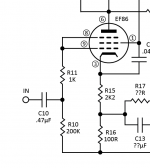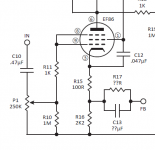Oh okay, I think I understand. Why do that? To reduce the potential between the heater and the rest of the tube for some reason? Oh, I remember, to reduce noise. I see.
..Todd
..Todd
Oh okay, I think I understand. Why do that? To reduce the potential between the heater and the rest of the tube for some reason? Oh, I remember, to reduce noise. I see.
..Todd
Yes, for noise....although I'm unclear on the effects on the KT88's, since they are fixed bias. They'll certainly handle it, as V(h-k) is about 200V according to the datasheet. V(h-k) for the 6GK5 & EF86 is 100V. I suppose it pays to reduce the noise on the small signal stuff at the expense of the output tubes.
Hi TubeMack,
It's easy enough to omit.
It's probably there (I'm guessing) because the input sensitivity and impedance is such that that amp works fine with a 'passive preamp'; a volume pot, or stepped attenuator.
It can be drawn in as an option to leave or omit. I'd like to hear from the gurus how the pot is affecting the input impedance (or not) and input filter network.
I would prefer to use a passive attenuator rather than a preamp, if the amp is happy running that way.
..Todd
True, but as these are monoblocks, using separate attenuators on each amp would be rather cumbersome. I vote they be stricken.🙂
BTW revision 2 looks very nice, but R25, and R16 have been transposed?
One for the group:
While on the preamp subject, Is it true that triode strapping the EF86 won't provide enough gain for the NGF loop even when using a powered pre? Please forgive my tube ignorance on this!
Last edited:
While on the preamp subject, Is it true that triode strapping the EF86 won't provide enough gain for the NGF loop even when using a powered pre? Please forgive my tube ignorance on this!
The μ (amplification factor) of the 6GK5 is approx. 2.5X that of a triode wired EF86. Voltage gains approaching those obtained from small signal pentodes are possible with the 6GK5. Given the 6GK5's low RP, a 60X gain is possible with resistive loading. 😀 75X is easy enough, when CCS loading is employed. Remember what I said about gm and slew limiting. High μ and high gm in the same triode is not exactly common. This project is using the 6GK5 and 12AT7, which meet that uncommon description. 😉
True, but as these are monoblocks, using separate attenuators on each amp would be rather cumbersome. I vote they be stricken.
I agree strike the volume controls. An option that monoblocks offer is the use of short speaker cables and long interconnects to the preamp. That idea works only when the preamp has the low O/P impedance and current capability needed to charge and discharge the capacitance of the requisite shielded wire. No passive control center is up to the task. IMO, the place for passive volume controls is at the I/P of an "integrated" stereoblock amp.
True, but as these are monoblocks, using separate attenuators on each amp would be rather cumbersome. I vote they be stricken.🙂
Good point. They'll be gone in the next version.
BTW revision 2 looks very nice, but R25, and R16 have been transposed?
Good eye (actually R15 and R16). Will be fixed, Thanks.
..Todd
The μ (amplification factor) of the 6GK5 is approx. 2.5X that of a triode wired EF86. Voltage gains approaching those obtained from small signal pentodes are possible with the 6GK5. Given the 6GK5's low RP, a 60X gain is possible with resistive loading. 😀 75X is easy enough, when CCS loading is employed. Remember what I said about gm and slew limiting. High μ and high gm in the same triode is not exactly common. This project is using the 6GK5 and 12AT7, which meet that uncommon description. 😉
I agree strike the volume controls. An option that monoblocks offer is the use of short speaker cables and long interconnects to the preamp. That idea works only when the preamp has the low O/P impedance and current capability needed to charge and discharge the capacitance of the requisite shielded wire. No passive control center is up to the task. IMO, the place for passive volume controls is at the I/P of an "integrated" stereoblock amp.
OK, the EF86 stays pentode, with perhaps a modded schematic for the 6GK5 later if a circuit change gets posted. If someone building these wants to be adventurous, they could temporarily wire one block with the EF86, and the other 6GK5 for a little direct comparison. That should settle it! To bad about the socket requirements.🙁
Last edited:
OK, the EF86 stays pentode
Newbie questions...
- What's the difference (in practical terms)?
- How does one strap a pentode into a triode?
You don't need the input cap if your sources don't have offset.
The heater biasing reduces noise, but it also keeps the heater-cathode potential of the 12AT7 within the rated max.
The heater biasing reduces noise, but it also keeps the heater-cathode potential of the 12AT7 within the rated max.
Newbie questions...
..Todd
- How does one strap a pentode into a triode?
Tie the anode to g2 using a small R. Lowers the gain, eliminates partition noise, and makes for a more pleasant distortion spectra...among other things (can you tell I've been doing a lot of reading lately?)
To get the 6GK5 ball rolling, please see attached.
I have no idea how to wire the 10M45S supporting R's and 100R pot, etc, etc, but we gotta start somewhere.
I have no idea how to wire the 10M45S supporting R's and 100R pot, etc, etc, but we gotta start somewhere.
Attachments
Last edited:
You don't need the input cap if your sources don't have offset.
The heater biasing reduces noise, but it also keeps the heater-cathode potential of the 12AT7 within the rated max.
Is there another way to accomplish this, since we don't have a center tap on the heater winding?
To get the 6GK5 ball rolling, please see attached.
I have no idea how to wire the 10M45S supporting R's and 100R pot, etc, etc, but we gotta start somewhere.
That's gorgeous man, exactly what I needed. Now if only someone will fill in the blanks and details...
Is that input impedance too high at 1M?
..Todd
That's gorgeous man, exactly what I needed. Now if only someone will fill in the blanks and details...
Is that input impedance too high at 1M?
..Todd
Re: heater center tap: We do have a center tap on the heater.......
That's why Sy was suggesting the rework to lose the -ve 7.5V...then we don't need the FW bridge, etc. and can ground the heater CT or reference it to a higher V.
good question on the input impedance....too high and we pick up noise, too low and we load the source down........I imagine somewhere between 100K and 1M will probably work.
A voltage divider from the 240V B+ to ground using a 75K R and 27K R in series will give a heater reference of 63V between the R's and burn 2.3ma through the divider.
The 75K R should be a 2W and the 27K R should be a 1 W to keep the temps reasonable.
Last edited:
We do have a center tap on the heater.......
Bingo! And if we didn't have one, we could create one with two matched 100R resistors.
Re heater center tap: We do have a center tap on the heater.......
We do? I couldn't find any evidence of one on the Edcor web page for that transformer.
..Todd
We do? I couldn't find any evidence of one on the Edcor web page for that transformer.
..Todd
%&$^$^!!!😱-you're right!.....Time to spec another transformer......🙄
We do? I couldn't find any evidence of one on the Edcor web page for that transformer.
..Todd
Use two 100R across the secondary. Their junction forms a centertap.
Better still, use a 12V transformer, series the 6V tube heaters in pairs, connect the 12AT7 heater across the transformer, then use its centertap (pin 9) as the virtual CT.
- Home
- Amplifiers
- Tubes / Valves
- Mullard 5-20 KT88 PP blocks!

